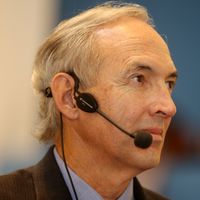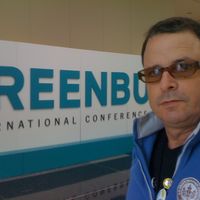I agree that many are scared off by the 19% stringency increase in 90.1-2010. As with many of the new issues in LEED the reaction seems to be based far more on a fear of the unknown than anything else. Relative stringency is determined as an average so there are project types for which the stringency only increased a few percent - multifamily and high process load facilities - and others who increased more that the average, on average. There are many other variables which enter into the equations as well, especially the selection of your proposed HVAC system. In general some systems just score better than others. Also keep in mind that the threshold were also reduced (smaller percent savings required to earn the same number of points). Off the top of my head - if you take advantage of the right HVAC system, I would put the difference between 90.1-2007 and 90.1-2010 at less than 10% for most projects. This means a loss of 2 - 3 points.
LEED 2009 Registration Extended to October 2016
The market needs additional time to prepare for LEED v4, says USGBC, in keeping LEED 2009 registration open longer.
October 29, 2014

The U.S. Green Building Council (USGBC) has decided that requiring new LEED projects to register for LEED v4 as of June 2015 was too soon and has shifted that date back to October 31, 2016. In an announcement released this morning, USGBC said that it was giving the market more time to get ready for LEED v4 based on feedback it received during last week's annual Greenbuild conference.
According to USGBC, 61% of respondents to a survey said they are “not ready” or “unsure” if they are ready for LEED v4 and require additional time to prepare.
USGBC launched LEED v4 in November 2013 as a more rigorous and fresh take on the LEED green building rating system, including new concepts like product transparency, whole building life-cycle analysis, and newer energy standards. The package came with a cushion: leading-edge LEED projects could register for LEED v4 right away, but you could keep registering for LEED 2009 until the window closed in June 2015. Want to play it safe? Register your project now for LEED 2009; upgrade to LEED v4 later when the kinks are worked out.
As of earlier this month, nine LEED v4 projects had been certified (one of which has shared its full documentation with LEEDuser), and 304 had started the process by registering during 2014. That's 15 times fewer than the 4,493 LEED 2009 projects registered to date. Between those numbers, the Greenbuild survey, and other market feedback, USGBC apparently decided it had heard enough and extended the LEED 2009 window another 16 months.
In a press release, Rick Fedrizzi, CEO of USGBC, said, “When USGBC launched LEED v4 last year, we set out with one goal in mind—to raise the bar in a way that challenges the building industry to reach higher than ever before. This is our nature and USGBC and its members’ collective mission. However, the market has requested additional time to prepare for LEED v4, so we are responding. “
You rely on LEEDuser. Can we rely on you?
LEEDuser is supported by our premium members, not by advertisers.
Go premium for $... »Fedrizzi added, "Our international LEED users, which account for some 50% of new LEED registrations, have also indicated they would like to have more time to move onto the new rating system. This extension will be especially helpful to them.”
The LEED v4 Materials and Resources (MR) credits have caused the most angst for LEED users, with many raising questions about whether the new Building Product Disclosure and Optimization credits are too complicated, not workable, or simply not a good idea.
That credit might get an overhaul. Also at Greenbuild last week, USGBC announced a Supply Chain Optimization Working Group, the charter of which is not confined to the vague Option 3 of Building product disclosure and optimization—material ingredients; it's also tasked with "explor[ing] new and innovative ideas to evolve" all three options of that credit, which includes a variety of programs. (Nadav Malin, president of BuildingGreen, which publishes LEEDuser, has been tasked with facilitating the working group, working with Scot Horst, chief product officer at USGBC.)
USGBC and the Green Building Certification Institute (GBCI) have not announced whether the change will impact credentialing, which switched over earlier this year to LEED v4 based exams for LEED Green Associates and LEED Accredited Professionals (LEED APs). Our guess is that there will not be a change here.
Mara Baum, vice president and sustainable design leader for healthcare at HOK, reacted positively to the news. She told LEEDuser, "This will help ease the transition to a very different and challenging system for design practitioners, owners, and manufacturers alike. Progressive organizations will continue their shift towards v4 criteria, while others can continue to advance their projects with v2009. USGBC will continue to develop incentives to encourage teams to either switch to v4 or to substitute v4 credit language where appropriate."
Referring to the 18-month cushion included in the LEED v4 launch, Baum noted, "This is the second time that required registration for v4 has been delayed. The first delay allowed USGBC to put more effort into fine-tuning tools such as the online LEED credit library and Web-based reference guide. Ironically the LEED tools are more advanced at this point than they had been at the release of 2009—it’s the market that isn’t ready yet. The roll out of LEED v4 would have been particularly challenging in jurisdictions that require certification for all buildings, or all buildings of a certain size and/or typology."
What's your reaction to the extension of LEED 2009?
Comments
I agree with your concerns
I agree with your concerns and I'm particularly concerned that the USGBC is looking at overhauling the construction credits. We've already invested in changing our documentation process. It's true that early adopters will have difficultly acheiving these credits. But it's the right "next step". Maybe reduce some of the requirements (ie 10 instead of 20 EPDs) for the early adopters, but don't overhaul.
I think that you're right on
I think that you're right on the money about the Energy standard being the issue, Martha. I've started hearing, even from folks in Europe, that v4 is not only better than v3, it's actually easier to work with. I think that the main reason folks haven't been opting into v4 is that they know they'll get fewer energy points.
I agree that 18 months is too
I agree that 18 months is too much time. 12 months would have been more appropriate and should have been plenty of additional time to accomplish the goal of letting everyone adjust. As you mention, the credentialing aspect of this is definitely problematic; it will be interesting to see if they make any adjustments in that regard.
LEED v4 Extension
I think you are going to find most constituents to be very pleased to hear this news. The market wasn't ready, design teams weren't ready, spec writers and manufacturers weren't ready, and owners were definitely not ready to fork over the added soft costs for LEED project administrators to research new credit requirements and ascend the learning curve.
My main concern with the previous timeline for v4 was that commercial building owners would look at it and decide there was no way they were going to ever pursue it. I think if this delay ultimately leads to greater v4 market adoption then it is the right move.
Let's not forget that progressive owners can still pursue v4 if they wish. In Massachusetts the state school building authority mandated LEED v4 on all new projects moving forward, so there will be a few of us getting our hands dirty and advancing v4 in the interim.
Chris, I surely hope these
Chris,
I surely hope these rumors won't become reality and the politics won't get the MSBA regulations to go backwards. That is how I see the USGBC's move, making everyone go backwards - I am extremely disappointed once more. I totally agree with your comment about being 3 codes behind once we get to October 2016. Between ZNE becoming quite integrated in many projects and some interest with LBC, this could be quite damaging to the LEED brand in general. Let's work to keep v4 in MA Schools!!!
Brian, Hi!
Two things: 1) MA-CHPS is no
Two things:
1) MA-CHPS is no longer an alternative. It disappeared when the new MA energy code (IECC 2012) was adopted
2) Due to the USGBC's lack of confidence in V4, I hear rumors that the MSBA is considering relaxing the requirement to use V4.
Steven - Thanks for your
Steven - Thanks for your reply. Please tell Martine and Steve Vincent I said hello!
Hi Brian, The requirement for
Hi Brian,
The requirement for all schools is to achieve LEED certified at a minimum; previously this was under v3, and as of July 2014 it is now under v4. The additional 2% reimbursement package is for achieving Silver. CHPS is still an alternative, though it is becoming less of a consideration in MA. Perhaps the requirements of LEED v4 will change that.
Steven - Thanks for your note
Steven - Thanks for your note about MA schools adopting v4. I was unaware of this. Is the SBA requiring this of all schools in order to receive funding, or is this only to receive the additional 2% budget allowance for the green schools designation? Also, are they still recognizing CHPS as a preferred alternative to LEED?
Changing from LEEDv4 to LEED 2009
I registered a project under LEEDv4 (#100038645) because my anticipated completion was past the LEEDv4 sunset date. Now that the registration deadline for LEED 2009 has been extended to 10/31/16, I assume the corresponding sunset date has been extended to 10/31/22 or thereabouts. The project and associated documentation should be complete prior to the LEED 2009 revised sunset date. I would like to change my project registration from LEEDv4 to LEED 2009. Any word as to whether this will be possible?
Response from USGBC regarding
Response from USGBC regarding moving from LEEDv4 to LEED 2009 is as follows:
Project data cannot be moved between platforms; however, the project can be re-registered in LEED 2009.
1. Back-up all documentation presently uploaded within the project. Please note that any documentation uploaded to LEED Online and any information in the forms will be lost as part of this process.
2. Re-register the project in LEED 2009.
3. E-mail copy of invoice.
4. A refund of registration fees already paid for the existing project will be processed.
5. USGBC will deactivate the old project.
Please note that you must contact USGBC directly to facilitate this process as there is a reference number/subject line associated with the project for tracking purposes.
Brian...After X number of
Brian...After X number of years working with TAGs and volunteers and staff to get the darn thing out into the marketplace I'm dammed if I going to let a very small cadre p**s all over it!
We committed to signing up as many clients as we could in Version 4 and we succeeded with not just the first but the first and the second Version 4 Platinums'....trouble is and what really upsets the whole apple cart is that both of them were LEED EB...the very rating system that USGBC is sidelining with dynamic plaque.
There are NO PROBLEMS running version 4 in EB...none. In several cases the credits are actually easier...and yes I know the Energy Star went to 75.
So, 'why would I want to?...because it's a leadership position and if USGBC management don't want to lead well nuts to them 'cause I do!
Hi Berry, v4 is still
Hi Berry, v4 is still available. Question is, why would you want to?
Tristan, I don't totally
Tristan, I don't totally disagree...it's more the 'unintended consequences' that come up. Primarily this is a timing issue with our larger clients who we have been working with us on re-certification. Having set re-certification calenders on 4.5 million square feet, funded those calenders based on the dropping of V3 and now to find all that is reversed leaves us in difficult positions.
On one hand the delay MAY help the client....on the other will there be further changes or a reversal of the v4 to v3 slippage next week when the board meet to review the input?
The lack of clear leadership is disconcerting.
Are we seriously suggesting
Are we seriously suggesting that we are going to allow registrations to back slide?
Thank you Tristan for the
Thank you Tristan for the reply. I have the same question into USGBC and I will post their response.
Hi Perrilyn! I also
Hi Perrilyn!
I also registered a project in v4 anticipating that the sunset date would occur before we begin design. Given this extension and the fact that it is a design build project, we will likely be into construction documentation before the new 2016 sunset date. I am hoping that the process for reverting to v2009 is painless.
Tristan, any insight on this?
LEED v4 Extension
USGBC raised the bar, but then lowered it again? The bottom line is that LEED v4 is an unworkable standard for most building owners and facility managers, significantly raising costs for LEED certification without adding any additional benefits. Don't you think we can expect to see another extension in 2016 or a significant modification to the standard?
I agree with Jerry. He was
I agree with Jerry. He was one of the people who understood that incremental change (v2.0, 2.1, 2.2,...) was the way to keep a standard moving upwards, and not overwhelming the market.
Going from LEED 2009 to LEED v4 in one massive change was a mistake. LEED v2 and v2009 did not change as much from prior versions as v4 changed v2009.
As far as LEED EB is
As far as LEED EB is concerned there are NO difficulties with version 4. Of course there are a few credits that still require tweaking but on the whole the USGBC have done a great job with EB in version 4
Jerry Yudelson, the commenter
Jerry Yudelson, the commenter above, is the President of Green Building Initiative (GBI), the administrator of the Green Globes system.
Friendly competitor or
Friendly competitor or nemesis? Stay classy.
Market transformation
Market transformation succumbs to market share. Maybe if they push it back far enough we'll get V5 out. But then v4 was suppose to solve all of the v2009 issues and that has worked so well.
Extension of LEED 2009 Registration Period
Given the changes embodied in LEED v4 and the feedback from users I think that USGBC made a very wise decision. This will give users more time to assimilate the changes and prepare for the changeover while continuing to use LEED 2009. For those firms either already using LEED v4 or just starting to use LEED v4 this change will allow them to continue on that path. It will also give both USGBC and users more time to educate clients about LEED v4.
Agreed with Janika and other
Agreed with Janika and other posters above - I'm also disappointed with the extension, and with the lack of transparency and consensus involved in the decision. At this point, v2009 is fairly standard in many of our markets, but there is no motivation for our clients to pursue v4 unless there is an immediate sunset date for v2009. I'm faced with answering questions across our firm regarding the discrepancy between v4 accreditation requirements and open registration for v2009. Educating clients (and even designers) on v4 becomes much more difficult when they realize that they are not required to pursue v4 for some time. The point of LEED has been to push the market forward, and I'm afraid the delay is only causing fragmentation at this time.
I'm very disappointed with
I'm very disappointed with the extension. On most of our projects, if the project goal is Platinum, the only way to get there reasonably at this point is under V3. However, we've been able to advocate for pursuing V4 anyways because of the sunset date and the leadership position that some of our clients are in. This is a great thing! Not all projects should be able to reach Platinum and I was excited for a new challenge after so many years of the same old strategies and conversations. Now there's no motivation for most of our clients to do V4 at all. Extending the sunset date will keep most projects and firms in V3 until they absolutely have to change. This will keep the market from getting up to speed and make V4 irrelevant even before it gets launched.
Might drive some folks to v4,
Might drive some folks to v4, I like it Christopher!
EBOMEBOM is an acronym for
EBOM projects using the Pilot ACP: EAp2 Energy Jumpstart (buildings with low ENERGY STAR scores improving by 20%) are limited to the Certified level. Perhaps a compromise would be limiting any LEED 2009 registered after June 2015 to the Certified level?
Granted, if the sunset date stays the same, this isn't really allowing buildings to use LEED 2009 longer; it just changes when the huge registration spike happens, which happens the day before every rating system closes.
Try to simplify... One
Try to simplify...
One amoeba, two amoeba..
one globe, two globe, - one
one globe, two globe, - one star, two star - oopps already taken
Elements - Fire, Earth, Water, Wind
Trees - Pine, Maple, Oak, Redwood
Water - pond, creek, river, ocean
Soil - minerals, bacteria, fungi, humus
Should be something to do with life. Which is what we are really trying to sustain.
I'm not sure what we would
I'm not sure what we would call the top 3 cert levels for projects using v3 after the cut-off, perhaps naming them after conflict resources (oil, fur, etc.), or after notorious building materials (asbestos, vinyl, etc.) but for the 40-point threshold:
- Certified becomes Pacified
Obviously this is in jest, as while sufficiently capable project teams have no excuse for using v2009 after June 15th 2015, I don't want to make light of the efforts of project teams who aren't able to use it for legitimate reasons (whatever those might be).
On a serious note, I would hesitate to throw too much energy behind a broad update to v2009 (although I like the idea of republishing it with addenda under the banner v3, and maybe also removing the Platinum tier), as if program development resources are put behind this, I'm afraid that our now-extended closing date would be more likely to slip indefinitely.
The Extension: Great news, a
The Extension: Great news, a very good thing! The market simply isn't ready or in many cases, able to hit the rigor of LEED v4. For example, A Sarasota, FL Sustainability-Architecture firm brought me in to help push along the LEED EBOM v4 process with their client, The University of South Florida. Almost immediately the team and I discovered that USF couldn't achieve v4 prereques, so we backed into v3.
Rating System Titles-Branding: I've always understood LEED 2009 as the evolution of 1. Rating Systems 2. LEED Accreditations 3. LEED Online. I always refer to the rating systems as v3 first and then as Marcus does v3/2009, but try to drive home the v3 indicator. There's no question there's confusion. I personally refer to rating systems commonly by number. i.e., LEED NC v3, LEED CI v3, LEED NC v2.2, LEED NC v4, LEED for Schools v2.0/v3 etc.
On another topic..
To me, one of the biggest issues we face with LEED adoption is the terrible design of LEED Online.
While we are at it perhaps we
While we are at it perhaps we could change the names of the levels of certification. Never liked the precious metals thing. This might help differentiate v3/2009 from v4 as well.
What would it take to change
What would it take to change the name, LEED 2009, to what it really is LEEDv3 (LEED 2009 PLUS addenda)? If officially the name changed to LEEDv3, it would reflect that the standard is comprehensive of updates and had return to be a leadership document rather than appearing to be a 2008-developed document in use in 2016!
It will only ever show up on
It will only ever show up on their radar when it is required. The delay won't change that.
Ross - I agree with you. The
Ross - I agree with you. The delay is a good thing. Many many people in the A/E/C and ownership roles are still struggling with understanding the nuances of v3!
I wonder if v3 and v4 could live side by side for a while longer. For example, a project listed under v3 after the cut of date could be limited to only achieving Certified or Silver status, while v4 projects could start at Silver and be allowed to pursue Platinum. It puts a hierarchy in the rating systems themselves, but still allows laggards to continue with the processes and systems they have spent years (and many dollars) refining to suit v3. I have spoken to many CRE leaders and LEED v4 is simply not on their radar. Not even a little bit.



















Add new comment
To post a comment, you need to register for a LEEDuser Basic membership (free) or login to your existing profile.